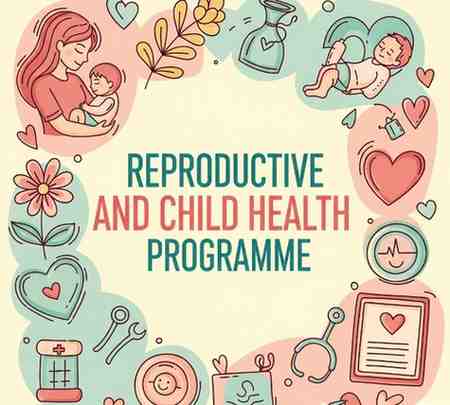
Your Account
Designed by Zeptt Technologies

The Reproductive and Child Health (RCH) Programme is a comprehensive approach introduced by the Ministry of Health and Family Welfare, Government of India under the National Health Mission (NHM). It aims to improve the reproductive health status of the population and reduce maternal and child morbidity and mortality through a life-cycle approach.
In Ayurveda, reproductive health is closely associated with the concept of Garbha Sambhava Samagri (essential factors of conception) and the care of garbhini, sutika, and shishu as described in classical texts.
GOALS OF RCH PROGRAMME
To reduce maternal mortality rate (MMR) and infant mortality rate (IMR).
To provide universal access to reproductive health services, including family planning, antenatal care, safe delivery, and postnatal care.
To ensure healthy survival of the newborn and child.
To improve the overall quality of life of women and children through healthcare access and education.
To promote responsible reproductive behavior and gender equality in health.
OBJECTIVES OF RCH PROGRAMME
To provide essential obstetric care and reduce complications related to pregnancy and childbirth.
To promote institutional deliveries through schemes like Janani Suraksha Yojana (JSY).
To ensure access to safe abortion services.
To provide contraceptive services and encourage birth spacing.
To prevent and manage reproductive tract infections (RTIs) and sexually transmitted infections (STIs).
To provide nutritional support to pregnant and lactating mothers.
To reduce the total fertility rate (TFR) to replacement levels.
To improve child health through immunization, breastfeeding promotion, and control of common childhood illnesses.
STRATEGIES OF RCH PROGRAMME
1. ESSENTIAL MATERNAL HEALTH CARE SERVICES
Regular Antenatal Check-Ups (ANC)
Promotion of Tetanus Immunization, Iron & Folic Acid Supplementation, and calcium
Institutional delivery under skilled birth attendants
Emergency Obstetric Care (EmOC) at First Referral Units (FRUs)
Postnatal care (PNC) up to 42 days after delivery
2. CHILD HEALTH STRATEGIES
Universal Immunization Programme (UIP)
Promotion of Exclusive Breastfeeding for 6 months
Introduction of Complementary Feeding after 6 months
Management of diarrhea with ORS and zinc, and acute respiratory infections (ARI)
Home-based Newborn Care (HBNC) and Facility-based Newborn Care (FBNC)
3. FAMILY PLANNING SERVICES
Promotion of modern contraceptive methods (IUCD, sterilization, pills, condoms)
Ensuring accessibility and affordability of contraceptives
Focus on male participation and counseling services
4. ADOLESCENT REPRODUCTIVE AND SEXUAL HEALTH (ARSH)
Addressing the health needs of adolescents
Promotion of menstrual hygiene, prevention of early pregnancy and STIs
Counseling and education through Adolescent Friendly Health Clinics (AFHCs)
5. MANAGEMENT OF INFERTILITY
Awareness and management of causes of infertility
Support services including counseling, diagnostic services, and referral
6. PREVENTION & MANAGEMENT OF RTIs/STIs AND HIV/AIDS
Syndromic management of infections
Voluntary counseling and testing for HIV/AIDS
Safe sex promotion and prevention of mother-to-child transmission (PMTCT)
7. SCHEMES AND INTERVENTIONS UNDER RCH
Janani Suraksha Yojana (JSY)
Janani Shishu Suraksha Karyakram (JSSK)
Rashtriya Bal Swasthya Karyakram (RBSK)
Pradhan Mantri Surakshit Matritva Abhiyan (PMSMA)
AYURVEDIC PERSPECTIVE ON RCH GOALS
सन्ततौ ह्यविकाराय गर्भिण्या आहिता क्रिया।
(Charaka Saṃhitā Śārīra Sthāna 8/32)
— All actions (chikitsā and ahāra-vihāra) done during pregnancy are aimed at the healthy development of the fetus and protection of the mother.
सर्वं हि गर्भिण्या कार्यं सुखप्रसवहेतवे॥
(Aṣṭāṅga Hṛdaya Uttara Tantra 2/9)
— Every regimen prescribed for the pregnant lady is aimed at safe and uncomplicated delivery.
शुक्रार्तवसमुत्थाने गर्भे दोषा न संस्थिताः।
(Suśruta Saṃhitā Śārīrasthāna 10/5)
— A well-balanced union of shukra and artava (sperm and ovum) ensures the health of the garbha (fetus), free from doshic disturbances.
GARBHINI PARICHARYA (ANTENATAL CARE)
Monthly dietary and lifestyle regimens
Use of medhya rasayanas, sattvika ahara, and stress-free environment
Use of Rakta-shodhaka dravyas to prevent garbha vikriti
Avoidance of vyayama, rajaswala sangama, agni, and shoka
SUTIKA PARICHARYA (POSTNATAL CARE)
First 1.5 months (45 days) considered as delicate for sutika
Deepana-pachana, snigdha ahara, and abhyanga
Strengthening of apana vata with yoni-basti, pichu, and dhupana
KAUMARABHRITYA (CHILD CARE)
Stanyapana (breastfeeding) within one hour of birth
Use of ghṛta, madhu, bala churnam for immunity
Ayurvedic lehana (herbal licking) and prashana practices
Classical vaccines: Svarna prashana described for immunity enhancement
INTEGRATION OF MODERN STRATEGIES WITH AYURVEDA
Encourage integration of Ayurvedic antenatal care into primary health care
Utilize Ayurvedic immuno-modulators (rasayana) in pediatric health
Promote safe delivery with both Ayurvedic and Allopathic collaboration in PHCs
Inclusion of Ayurveda-based counseling in adolescent reproductive health
Use of Ayurveda yoga & nutrition support in infertility management